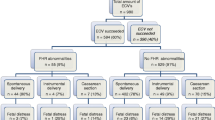Abstract
Objective
Recently, a non-invasive fetal electrocardiogram monitor has been approved for clinical usage in labour and delivery. To determine the fetal signal quality of vaginal breech deliveries in comparison with a case–controlled cephalic group during labour.
Study design
This case–control study was carried out at the Department of Obstetrics and Gynecology of the University Hospital Frankfurt between 1st July 2012 and 30th September 2012. A total of seven breech deliveries were evaluated. A case–controlled cephalic group with same gestational age and parity were selected from a previous trial.
Results
During first stage of labour, vaginal breech and cephalic delivery had no significant different fetal signal success rates (mean 87.8 vs. 85.7 %; p > 0.05). There was a trend of higher fetal signal success rates in the vaginal breech delivery group during second stage of labour (78.4 vs. 55.4 %; p = 0.08).
Conclusion
Similar fetal signal success rates in vaginal breech delivery in comparison to cephalic presentation were demonstrated using the new commercially available non-invasive abdominal fECG device (the Monica AN24TM).

Similar content being viewed by others
References
Bracht E (1936) Zur manualhilfe bei Beckenendlage. Ztschr Geburtsh Gynäk 112:271
Bracht E (1938) Zur Behandlung der Steisslage. Zentralbl Gynäk 62:1735
Plentl AA, Stone RE (1953) The bracht maneuver. Obstet Gynecol Surv 8:313–325
Hannah ME, Hannah WJ, Hewson SA et al (2000) Planned caesarean section versus planned vaginal birth for breech presentation at term: a randomised multicentre trial. Lancet 356:1375–1383
Glezerman M (2006) Five years to the term breech trial: the rise and fall of a randomized controlled trial. Am J Obstet Gynecol 194:20–25
Whyte H, Hannah ME, Saigal S et al (2004) Outcomes of children at 2 years after planned cesarean birth versus planned vaginal birth for breech presentation at term: the international randomized term breech trial. Am J Obstet Gynecol 19:864–871
Kotaska A, Menticoglou S, Gangnon R et al (2009) Vaginal delivery of breech presentation. SOGC clinical practicse guideline. JOGC 226:557–566
Deutsche Gesellschaft für Gynäkologie und Geburtshilfe. Leitlinie: Geburt bei Beckenendlage. DGGG Stand Januar 2010. http://www.dggg.de/leitlinien/aktuelle-leitlinien/3-praenatal-und-geburtsmedizin/
ACOG Committee on Obstetric Practice (2006) ACOG Committee Opinion No. 340. Mode of term singleton breech delivery. Obstet Gynecol 108:235–237
Louwen F, Leuchter LM, Reitter A (2012) Bekcenendlagengeburt––mehr als Sectio vs Spontangeburt. Z Geburtsh Neonatol 216:191–194
Hofmeyr GJ, Impey LWM. RCOG guideline No. 20b. The management of breech presentation. 2006. http://www.rcog.org.uk/print/womens-health/clinical-guidance/management-breech-presentation-green-top-20b
Reinhard J, Louwen F (2012) Non-invasive foetal ECG––a comparable alternative to the doppler CTG? Geburtsh Frauenheilk 72:211–214
Reinhard J, Hatzmann H, Schiermeier S (2008) Fetales elektrokardiogramm (EKG) als alternative der doppler-kardiotokografie (CTG) zur antepartualen Überwachung des Feten––erste Ergebnisse. Z Geburtsh Neonatol 212:226–229
Reinhard J, Hayes-Gill BR, Yi Q, Hatzmann H, Schiermeier S (2009) Signalqualität der nicht-invasiven fetalen Echokardiographie (EKG) unter der Geburt. Geburtsh Frauenheilk 69:703–706
Reinhard J, Hayes-Gill BR, Yi Q, Hatzmann H, Schiermeier S (2010) The equivalence of non-invasive foetal electrocardiogram (fECG) to doppler cardiotocogram (CTG) ultrasound during the 1st stage of labour. J Perinat Med 38:179–185
Reinhard J, Hayes-Gill BR, Schiermeier S, Löser H, Niedballa LM, Haarmann E, Sonnwald A, Hatzmann W, Heinrich TM, Louwen F (2011) Uterine activity monitoring during labour––a multi-centre, blinded two-way trial of external tocodynamometry against electrohysterography. Z Geburtsh Neonatol 215:199–204
Reinhard J, Hayes-Gill BR, Schiermeier S, Hatzmann W, Heinrich TM, Louwen F (2013) Intrapartum fetal and maternal heart rate ambiguity––a comparison of doppler ultrasound CTG and the abdominal fetal electrocardiogram with maternal electrocardiogram. Gynecol Obstet Invest 75:101–108
Sänger N, Hayes-Gill B, Schiermeier S, Hatzmann W, Yuan J, Herrmann E, Louwen F, Reinhard J (2012) Antepartales fetales nicht-invasives EKG statt CTG––Eine bessere Alternative zum CTG? Geburtsh Frauenheilk 72:630–633
Reinhard J, Hayes-Gill BR, Schiermeier S, Hatzmann W, Herrmann E, Heinrich TM, Louwen F (2012) Intrapartum signal quality with external fetal heart rate monitoring––a two way trial of external doppler CTG ultrasound and the abdominal fetal electrocardiogramm. Arch Gynecol Obstet 286:1103–1107
Rooth G, Huch A, Huch R (1987) Guidelines for the use of fetal monitoring. Int J Gynecol Obstet 25:159–167
Deutsche Gesellschaft für perinatale Medizin, AG für materno-fetale Medizin, deutsche Gesellschaft für Gynäkologie und Geburtshilfe. Anwendung des CTG während Schwangerschaft und Geburt. Frauenarzt 2004; 45:979–989
Rooth G, Huch A, Huch R (1987) FIGO news: guidelines for the use of fetal monitoring. Int J Gynaecol Obstet 25:159–167
Solum T (1980) A comparison of three methods for external fetal cardiography. Acta Obstet Gynecol Scan 59:123–126
Bakker PCAM, Colenbrander GJ, Verstraeten AA, Van Geijn HP (2004) The quality of intrapartum fetal heart rate monitoring. Eur J Obstet Gynecol Reprod Biol 116:22–27
Amer-Wahlin I, Hellsten C (2001) Nore’n H et al cardiotocography only versus cardiotocography plus ST analysis of fetal electrocardiogram for intrapartum fetal monitoring: a swedish randomised controlled trial. Lancet 358:534–538
Fraser WD, Turcot L, Krauss I, Brisson-Carrol G (2007) With-drawn: amniotomy for shortening spontaneous labour. Cochrane Database Syst Rev 18: CD000015
Conflict of interest
Monica health care Ltd. has sponsored various other studies at a total amount of around 65.000€.
Ethical approval
Ethics approval was granted by the local university of Frankfurt ethics committee.
Author information
Authors and Affiliations
Corresponding author
Rights and permissions
About this article
Cite this article
Sänger, N., Louwen, F., Reinhard, J. et al. Signal quality of non-invasive fetal electrocardiogram in vaginal breech delivery: a case–controlled study. Arch Gynecol Obstet 288, 1017–1020 (2013). https://doi.org/10.1007/s00404-013-2860-6
Received:
Accepted:
Published:
Issue Date:
DOI: https://doi.org/10.1007/s00404-013-2860-6




